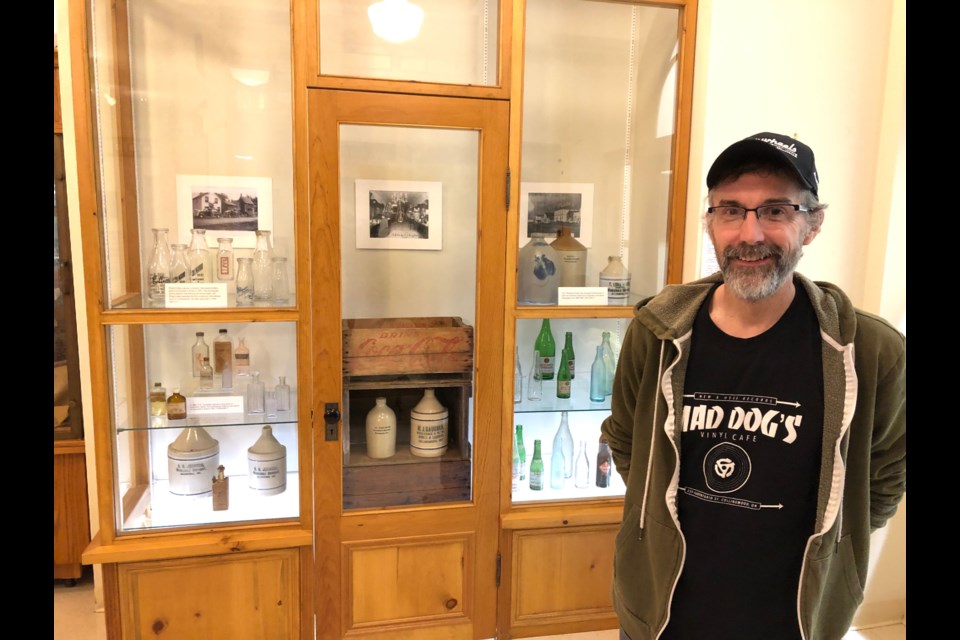A trip to a decommissioned town dump and a 10 ounce, brown, ribbed Orange Crush bottle was the beginning of a lifelong treasure hunt for one Collingwood man.
Sean Redman made that trip to the dump when he was a kid, led there by his cousin Steve. The brown soda bottle was the first of many Redman would collect to form part of his vast collection of Collingwood artifacts.
“My pop bottle collection eventually got way out of control and I decided I had to narrow my focus a little,” said Redman, who has hunted, bought, and traded for new items over the years. “I had several old Collingwood bottles and had learned there was … a pretty rich history of bottling here. Everything from milk to pharmaceuticals … Collingwood sent stuff all over the world. I have seven bottles from the St. Lawrence.”
He’s since traded his first Orange Crush bottle to John Saunders for a black and white Coca Cola sign, which he still has.
Redman’s curated collection now contains 53 bottles and jugs, and six crates, all originally from Collingwood. He collects many Collingwood artifacts, but particularly loves the way glass looks in the light.
One jug, a grey ceramic with blue markings came from a downtown merchant called The Checkered Store, because the building was literally checkered. The bottle can be traced back to the 1860s, when it was made by Bradford Pottery Works for the Checkered Store. What it contained is a mystery, but ceramic jugs like that could have held maple syrup, liquor, wine, and a list of other things.
A recent trip to the Rodney Street Dump brought Redman a 3.5-inch, cobalt blue Canadian-made poison bottle. There are bumps raised from the glass and the word poison is also written in raised glass down the bottle, so it was clear – even in the dark – this wasn’t a drinking potion.
One of the more spectacular pieces in his collection is a small, clear bottle of AH Johnson Whooping Cough Cure, which is still in a cardboard sleeve with the paper list of AH Johnson medicines available inside. The bottle is sealed with a cork stopper and still contains some liquid. It was found in the cupboard of an abandoned building.
Redman does buy some items from ebay, but he gets a thrill out of digging through an old dump site or a backyard.
“It’s like finding treasure, and there’s nothing better than free,” said Redman.
Once he finds a bottle or other item he’s interested in, he’ll clean the muck off it while hes “in the hole” and then take it home to clean it some more. If it’s something he already has, he adds it to his pile of “tradesies.”
If he’s not sure of the bottle’s origin or the name of the merchant on the bottle, he’ll head over to the Collingwood Museum for some research.
“When I find something I want to learn about it, I want to research it,” said Redman. “It’s sort of passively learning about the history of Collingwood ... I love the history of Collingwood.”
While places to dig in Collingwood are becoming more rare as growth happens, he’s still got a few unexcavated options.
The former dump off Huron Street will eventually be home to the Parkbridge Head Office, and when crews start cleaning up the site, Redman and a few other collectors will be there to “follow the dirt.”
They save their vacation time for that kind of an excavation.
Redman also tends to find treasures in yards where there were once homesteads. In the days before municipal garbage services, people buried garbage in their backyards.
Redman said summer kitchens were great places for treasures, because people would put old bottles and garbage under the kitchen to keep animals out of there.
Old privies also tend to be rich in treasures, they were catch-alls for all sorts of waste.
Redman keeps his collection up at his house, which also includes the restored remains of the last wooden shipyard building in Collingwood.
“I live in my museum,” said Redman.
She does share his items with the general public online through his Facebook page called The Collingwood Collection.
For the next few months, you can also see a portion of his collection at the Collingwood Museum. Redman’s bottles are on display at the museum as part of a new initiative to showcase community collectors.
Museum Assistant Lindsay Cook said the initiative will continue to change every couple of months and the display case will show-off loans from community residents.
“It’s going to be an interesting and personalized look at parts of Collingwood’s history,” she said.
If you have a collection you would like to showcase, contact museum staff online here or by phone at 705-445-4811.



